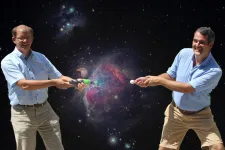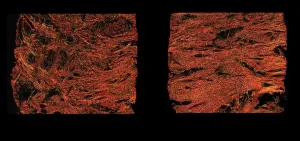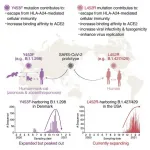Capturing electrons in space
How negatively charged molecules are created in interstellar environments?
2021-07-20
(Press-News.org) Interstellar clouds are the birthplaces of new stars, but they also play an important role in the origins of life in the Universe through regions of dust and gas in which chemical compounds form. The research group, molecular systems, led by ERC prize winner Roland Wester at the Institute for ion physics and applied physics at the University of Innsbruck, has set itself the task of better understanding the development of elementary molecules in space. "Put simply, our ion trap allows us to recreate the conditions in space in our laboratory," explains Roland Wester. "This apparatus allows us to study the formation of chemical compounds in detail." The scientists working with Roland Wester have now found an explanation for how negatively charged molecules form in space.
An idea built on theoretical foundations
Before the discovery of the first negatively charged carbon molecules in space in 2006, it was assumed that interstellar clouds only contained positively charged ions. Since then, it has been an open question how negatively charged ions are formed. The Italian theorist Franco A. Gianturco, who has been working as a scientist at the University of Innsbruck for eight years, developed a theoretical framework a few years ago that could provide a possible explanation. The existence of weakly bound states, so-called dipole-bound states, should enhance the attachment of free electrons to linear molecules. Such molecules have a permanent dipole moment which strengthens the interaction at a relatively great distance from the neutral nucleus and boosts the capture rate of free electrons.
Observing dipole-bound states in the laboratory
In their experiment, the Innsbruck physicists created molecules consisting of three carbon atoms and one nitrogen atom, ionized them, and bombarded them with laser light in the ion trap at extremely low temperatures. They continuously changed the frequency of the light until the energy was large enough to eject an electron from the molecule. Albert Einstein described this so-called photoelectric effect 100 years ago. An in-depth analysis of the measurement data by the early-stage researcher Malcolm Simpson from the doctoral training programme, atoms, light and molecules at the University of Innsbruck finally shed light on this difficult-to-observe phenomenon. A comparison of the data with a theoretical model finally provided clear evidence of the existence of dipole-bound states. "Our interpretation is that these dipole-bound states represent a kind of door opener for the binding of free electrons to molecules, thus contributing to the creation of negative ions in space," says Roland Wester. "Without this intermediate step, it would be very unlikely that electrons would actually bind to the molecules."
INFORMATION:
The work was supported by the Austrian Science Fund FWF, which also finances the PhD program Atoms, Light and Molecules (ALM) at the University of Innsbruck.
Publication: Influence of a supercritical electric dipole moment on the photodetachment of C3N-. Malcolm Simpson, Markus Nötzold, Tim Michaelsen, Robert Wild, Franco A. Gianturco, and Roland Wester. Phys. Rev. Lett. 127, 043001, https://journals.aps.org/prl/abstract/10.1103/PhysRevLett.127.043001
[Attachments] See images for this press release:

ELSE PRESS RELEASES FROM THIS DATE:
2021-07-20
Amsterdam, July 20, 2021 - Well over six million people globally have been diagnosed with Parkinson's disease (PD), which has an enormous impact on the lives of patients, their families, and caregivers and is incurring mounting costs for society. This special supplement to the Journal of Parkinson's Disease (JPD), guest-edited by noted experts Anat Mirelman, PhD, E. Ray Dorsey, MD, MBA, Patrik Brundin, MD, PhD, and Bastiaan R. Bloem, MD, PhD, reviews how digital technology is being used to reshape research and clinical care in PD.
Digital health technology is an umbrella term that spans a diverse range of applications, including body-fixed wearable sensors, non-contactable domestic sensors, smartphone apps, and videoconferencing and other telemedicine systems that allow for direct remote ...
2021-07-20
MINNEAPOLIS/ST. PAUL (07/20/2021) -- National data analyzed by University of Minnesota Medical School researchers show that nearly 40 percent of all funds used to pay for medical school are expected to come from family or personal sources and scholarships. The prevalence of these sources, however, varies widely by race and socioeconomic status.
Arman Shahriar, Varun Sagi and Lorenzo Gonzalez, all fourth-year students at the University of Minnesota Medical School, are co-lead authors of the study, which was published today in JAMA Network Open.
"Financing a four-year medical education requires upwards of a quarter-million dollars, and this amount has been rising faster than inflation since the 1960s. Prior to this study, ...
2021-07-20
Despite the best efforts of industry to work towards sustainability, most plastics (or polymers) are still made using non-renewable fossil fuels. However, researchers have now found an economical method for producing biobased acrylate resins. The study, published in the journal Angewandte Chemie, shows how all the synthesis steps, from initial building blocks right up to polymerization, can be carried out in a single reactor (one pot), minimizing environmental impact.
Most varnishes, adhesives and paints are made from acrylate resins, which are polymers of acrylic acid esters and methacrylic acid esters. The raw materials that form these ...
2021-07-20
The sight of felled trees and logging activity can be jarring for nature lovers, but from those sites can sprout young forest growth that's especially attractive to a familiar inhabitant of wooded areas throughout the Northeast - bats.
New findings from researchers at the UConn College of Agriculture, Health, and Natural Resources, published in Forest Ecology and Management, finds that a number of bat species native to the Northeast are highly active in newly created forest spaces, foraging for food at higher rates than is typical of mature forests.
Little is known about ...
2021-07-20
Vaccine hesitancy continues to be a hurdle in the development of widespread immunity within the U.S. population as the COVID-19 pandemic enters its second year.
Researchers at the University of Cincinnati College of Medicine have developed a computerized decision analytic model to compare projected outcomes of three vaccine strategies: a patient opts for a messenger RNA vaccine, a patient decides to get an adenovirus vector vaccine or the patient simply forgoes a vaccine altogether.
Pfizer and Moderna produce mRNA vaccines while Johnson & Johnson manufacture an adenovirus vector vaccine. The decision analytic ...
2021-07-20
Surgical scars treated with a molecule called alphaCT1 showed a long-term improvement in appearance when compared to control scars, according to multicenter, controlled Phase II clinical trials - a finding that could help surgeons improve patient outcomes.
Now, a public-private research team led by Rob Gourdie, professor and director of the Center for Vascular and Heart Research at the Fralin Biomedical Research Institute at VTC, has revealed clues about why and how it improves the appearance of scars.
The study, to be published in the August issue of the Federation ...
2021-07-20
When it was discovered in the 1980s in Argentina, this hadrosaur was diagnosed with a fractured foot. However, a new analysis now shows that this ornithopod commonly known as the duck-billed dinosaur actually had a tumour some 70 million years ago, as well as two painful fractures in the vertebrae of its tail, despite which, it managed to survive for some time.
This dinosaur, called Bonapartesaurus rionegrensis, was discovered in Argentinean Patagonia in the 1980s, and the first analyses of its fossils indicated an ailment of the foot, possibly a fracture, as the Argentinean palaeontologist Jaime Powell pointed out at the time. The study of this animal then came to a standstill until 2016, when Powell invited another team of scientists to resume ...
2021-07-20
The Indian Ocean has been warming much more than other ocean basins over the last 50-60 years. While temperature changes basin-wide can be unequivocally attributed to human-induced climate change, it is difficult to assess whether contemporary heat and freshwater changes in the Indian Ocean since 1980 represent an anthropogenically-forced transformation of the hydrological cycle. What complicates the assessment is factoring in natural variations, regional-scale trends, a short observational record, climate model uncertainties, and the ocean basin's complex circulation.
A ...
2021-07-20
PHILADELPHIA--Alzheimer's disease and related diseases can still only be confirmed in deceased patients' brains via autopsy. Even so, the development of biomarkers can give patients and their families answers during life: Alzheimer's disease can be accurately detected via peptides and proteins in a patient's cerebrospinal fluids (CSF), which can be collected through a lumbar puncture and tested while the patient is alive. In 2018, a new framework suggested combining three Alzheimer's disease biomarkers in CSF - pathologic amyloid plaques (A), tangles (T), and neurodegeneration (N), collectively called ATN. According to recent research from the Perelman School ...
2021-07-20
An international team of researchers led by Kumamoto and Tokyo Universities (Japan) have shown that the L452R mutation of the SARS-CoV-2 spike protein, which is common to two mutant strains (Epsilon and Delta), is involved in cellular immunity evasion via the human leukocyte antigen (HLA) A24, and enhances viral infectivity. HLA-A24 is one of the most prominent HLA-class I alleles, especially in East/Southeast Asian populations, which might make them particularly vulnerable to coronavirus variants with this mutation.
The ongoing novel coronavirus (SARS-CoV-2 or COVID-19) pandemic has, as of June 2021, infected over 150 million and killed over 3.5 million people worldwide. Vaccination drives ...
LAST 30 PRESS RELEASES:
[Press-News.org] Capturing electrons in space
How negatively charged molecules are created in interstellar environments?




